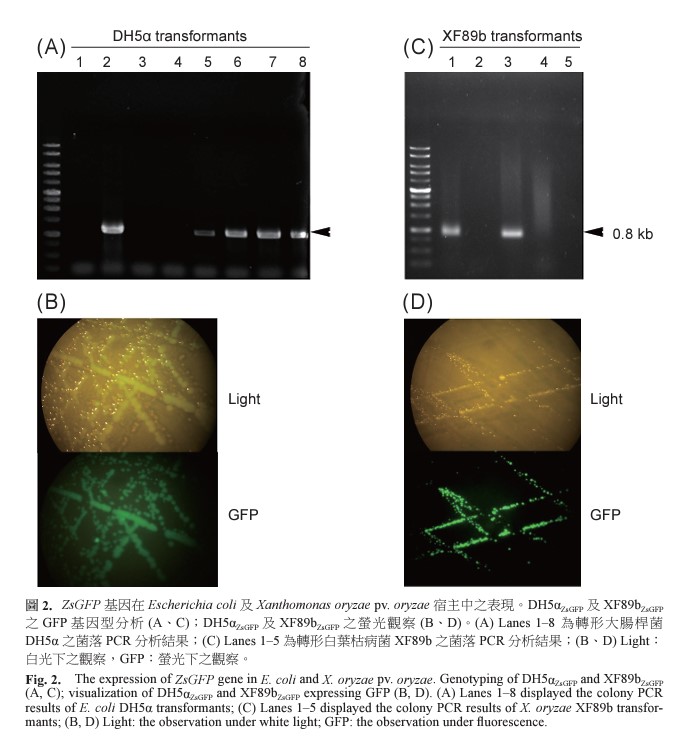All issues

Author:Da-Gin Lin*, Yu-Ling Lin, Chun-Wei Chen, Hui-Chen Lai, Yi-Wen Wang, Szu-Yi Chou, and Chang-Sheng Wang*
Abstract:
Detection of pathogen infection is an important step in pathogen-host interaction study. A Xanthomonas fluorescent expression plasmid, pRBBZsGFP, was constructed with a strong fluorescent gene ZsGFP and the pBBR1MCS vector for immediate detection of bacterial blight pathogen infection. The recombinant plasmid was transformed into Escherichia coli DH5α and Xanthomonas oryzae pv. oryzae XF89b, respectively. The transformants, DH5αZsGFP and XF89bZsGFP, were confirmed by PCR genotype analysis and the observation of continuously expression of green fluorescent proteins. After infection of ‘TNG67’ at the maximum tillering stage by XF89bZsGFP, the observation of ZsGFP was interfered with the fluorescence of chlorophyll. The results showed that the bacterial multiplication of XF89bZsGFP only could be observed at the incision site at 3 DAI (days after inoculation) and XF89bZsGFP colonized from the cutting site to leaf base at 7 DAI. Using dark-treated albino rice seedlings, the interference of chlorophyll fluorescence could be reduced and the multiplication and colonization of XF89bZsGFP could be detected in 0.5 h after inoculation and the maximum ?uorescence was observed on the same leaf in 1 h after inoculation. However, the ?uorescence was reduced in the following time course indicating that the multiplication and colonization of XF89bZsGFP might be suppressed by the endogenous immune system of rice. At 7 DAI, the stronger ?uorescence was observed again on the same leaf and extended continuously to the leaf base, suggesting that the rice immune system was broken down by the XF89bZsGFP. To our knowledge, this is the first report on the observation of X. oryzae pv. oryzae in rice plants. Importantly, this is a non-destructive system for pathogen detection and the multiplication and colonization of pathogen can be directly observed on the inoculated leaf. Therefore, the XF89bZsGFP and system established in this study can be served as a platform for real-time observation of virulence and pathogenicity of X. oryzae, and can also be applied to the study of the interaction between pathogen and host.
Key words:Xanthomonas oryzae pv. oryzae, ZsGFP gene, Xanthomonas fluorescent expression system, Investigation of disease progress, Pathogen-host interaction
Download:![]() PDF Links
PDF Links
- 1. Development of Tractor-Mounted Seedling Transplanter for Sweet Potato
- 2. Synergistic Effect of Additional Gas on the Toxicity of Phosphine to Sitophilus oryzae and Sitophilus zeamais (Coleoptera: Dryophthoridae)
- 3. Effects of Temperature and Solar Radiation on Growth Traits and Plant Elements in Purple Leafy Sweet Potato
 Submit your manuscript
Submit your manuscript
 Guide for authors
Guide for authors